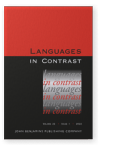Vol. 22:1 (2022) ► pp.43–76
Engaging with customer’s emotions
A case study in English-Spanish online food advertising
Informational-persuasive discourse may be encoded in promotional strategies through which a given product is described in a positive way to persuade potential customers. For this, evaluation may appeal to reason or may tickle emotions (Cook, 2001). This study compares the way in which advertising texts for herbal tea engage with customers’ emotions in English and in Spanish. We examined the strategies of ‘enjoying the experience’ and ‘aesthetic appeal’ from an Appraisal Theory approach (Martin and White, 2005). We categorised these according to the attitude sub-systems of ‘affect’, ‘appreciation’, and ‘judgement’, determined how explicit the evaluation was, and identified gradable resources. Results show that English texts display more ‘affect’-like resources that can awaken a desire in the customer. By contrast, in the Spanish sample ‘appreciation’ resources that evaluate the composition of the product play a greater role. ‘Enjoying the experience’ seems to engage with the customers’ emotions more overtly than ‘aesthetic appeal’.
Article outline
- 1.Introduction: Background and rationale for the study
- 2.Theoretical framework
- 2.1Informational-persuasive discourse: The HTPT
- 2.2Promotional strategies in online informational-persuasive discourse
- 2.3Appraisal Theory
- 3.Research objectives and methodology
- 3.1Research objectives
- 3.2The corpus
- 3.3Working procedure and annotation methodology
- 4.Results and discussion
- 4.1Promotional strategy: Enjoying the experience
- 4.1.1Parameter one: Attitude sub-systems
- 4.1.2Parameter two: Inscribed vs invoked evaluation
- 4.1.3Parameter three: Graduation
- 4.2Promotional strategy: Aesthetic appeal
- 4.2.1Parameter one: Attitude sub-systems
- 4.2.2Parameter two: Inscribed vs invoked evaluation
- 4.2.3Parameter three: Graduation
- 4.3Overall cross-linguistic insights
- 4.1Promotional strategy: Enjoying the experience
- 5.Conclusions
- Acknowledgements
- Notes
-
References
